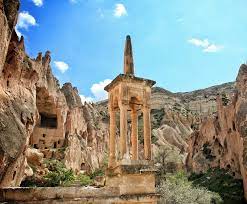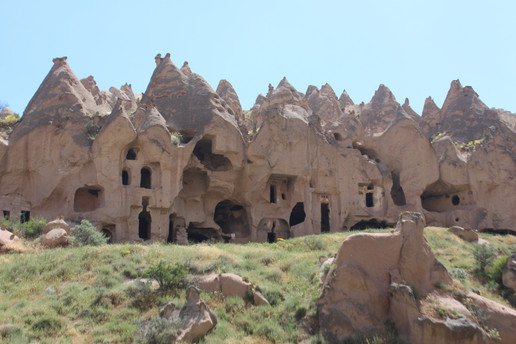Cappadocia's Open Air Museums
- Feb 28, 2024
- 8 min read
Updated: Oct 19, 2024
Cappadocia, a region in central Turkey known for its otherworldly landscapes, is home to two remarkable open air museums: Göreme and Zelve. These museums offer a captivating glimpse into the rich history, culture, and architectural heritage of Cappadocia. With their remarkable rock-cut churches, cave dwellings, and troglodyte life, these open air museums provide a unique opportunity to delve into the ancient past of this extraordinary region. In this article, we will explore the fascinating world of Göreme and Zelve museums, uncovering their history, architectural highlights, religious art, preservation efforts, and practical tips for visiting these captivating sites. Embark on a cultural journey as we unravel the treasures of Cappadocia's open air museums.
1. Introduction to Cappadocia's Open Air Museums
The Unique Heritage of Cappadocia
Cappadocia, located in central Turkey, is a region known for its breathtaking natural beauty and rich cultural heritage. It is a place where history and art merge seamlessly, creating a unique experience for visitors. One of the most captivating aspects of Cappadocia is its open air museums, which provide a glimpse into the region's fascinating past.
What are Open Air Museums?
Open air museums are open-air spaces that showcase historical, cultural, and architectural artifacts in their original settings. In Cappadocia, these museums offer a chance to explore the ancient cave dwellings, rock-cut churches, and monastic complexes that date back thousands of years. They offer a window into the lives of the people who once inhabited this extraordinary landscape.
2. Exploring Göreme Open Air Museum: A Cultural Journey
The Origins and Development of Göreme Open Air Museum
Göreme Open Air Museum is perhaps the most famous of Cappadocia's open air museums. It originated in the 4th century when Christian monks sought refuge in the caves, creating a thriving monastic community. Over time, these monks carved elaborate churches, chapels, and living quarters into the soft rock formations, showcasing their unique artistic talents.
Highlights of the Museum's Rock-Cut Churches
The rock-cut churches in Göreme Open Air Museum are a sight to behold. Adorned with stunning frescoes depicting biblical scenes, they provide a vivid glimpse into the Byzantine art of the time. Walking through the dimly lit interiors, visitors can marvel at the intricate details of these ancient masterpieces.
Exploring the Monastic Life and Cave Dwellings
In addition to the churches, Göreme Open Air Museum offers a chance to explore the monastic life and cave dwellings. Visitors can step into the living quarters of the early Christian monks, see their communal dining areas, and even discover hidden tunnels and escape routes. It's a fascinating journey into the daily life of those who once called this place home.
Discover more things to do in Göreme.
3. The History and Significance of Zelve Open Air Museum
Tracing the History of Zelve Open Air Museum
Zelve Open Air Museum is another remarkable site in Cappadocia that showcases the region's past. It was once a thriving monastic settlement, with its earliest traces dating back to the 9th century. Over time, it transformed into a bustling village, becoming a unique example of a rock-cut urban center.
Understanding the Unique Cultural Significance
Zelve Open Air Museum holds immense cultural significance as it offers insights into the evolution of Cappadocia's social and architectural history. The site is home to rock-cut houses, churches, and a mosque, providing a glimpse into the complex layers of the region's multicultural heritage.
The Transformation and Abandonment of Zelve
What makes Zelve particularly intriguing is its transformation and eventual abandonment. As the village expanded, the erosion of the soft rock made it unsafe for habitation. Eventually, in the 1950s, the entire village was relocated to a safer area nearby. Today, Zelve Open Air Museum stands as a testament to a once-thriving community and the challenges of living in such a unique environment.
4. Architectural Highlights in Göreme and Zelve Museums
Rock-Cut Architecture: A Marvel of Cappadocia
The rock-cut architecture found in both Göreme and Zelve Open Air Museums is a marvel of engineering and artistic expression. The ability to carve intricate structures out of the soft volcanic rock is a testament to the ingenuity and skill of the people who once inhabited these caves.
Comparing Architecture Styles in Göreme and Zelve
While both museums showcase rock-cut architecture, each has its own distinct style and character. Göreme's churches, with their ornate frescoes, exhibit a more refined Byzantine influence, whereas Zelve's structures reflect a mix of Byzantine, Seljuk, and Ottoman architectural elements.
Key Architectural Features in the Open Air Museums
In both museums, visitors can admire key architectural features such as stone-carved columns, arches, and domes. The interiors are often adorned with frescoes depicting religious scenes, offering a glimpse into the artistic and spiritual practices of the past.
Visiting the open air museums of Cappadocia, particularly Göreme and Zelve, is an opportunity to immerse oneself in a world that is both captivating and humbling. These museums allow us to appreciate the ingenuity, creativity, and resilience of the people who lived in this extraordinary landscape, leaving behind a legacy that continues to inspire awe and wonder today.Challenges in Open Air Museums.
5. Iconic Rock-Cut Churches: Religious Art and Frescoes
A Journey into Cappadocia's Christian Heritage
When you think of Cappadocia, images of hot air balloons and unique rock formations may come to mind. However, this region also holds a rich Christian heritage dating back centuries. The iconic rock-cut churches found in the Göreme and Zelve Museums provide a fascinating glimpse into this history. Stepping inside these ancient sanctuaries, you'll be transported to a time when faith and art coexisted harmoniously.
Examining the Rock-Cut Churches and Monastic Art
The rock-cut churches in Cappadocia are architectural wonders carved directly into the soft volcanic rock. These intricate structures, some dating back to the Byzantine period, feature stunning frescoes and religious iconography. As you explore these sacred spaces, pay attention to the details on the walls and ceilings – they beautifully depict biblical stories and scenes from the lives of saints. The skilled craftsmanship and attention to detail are awe-inspiring.
The Significance of Frescoes and Religious Iconography
Frescoes, the art of painting on wet plaster, played a vital role in Christian worship. These vivid and colorful depictions were not only a form of artistic expression but also a means to communicate religious teachings to the illiterate. The frescoes and religious iconography in Cappadocia's rock-cut churches offer a unique perspective on the spiritual beliefs and practices of the time. They provide a tangible link to the past and allow us to appreciate the devotion and imagination of the artists who created them.
6. Cave Dwellings and Troglodyte Life in Cappadocia
Understanding Troglodyte Architecture and Lifestyle
In addition to the rock-cut churches, Cappadocia is famous for its cave dwellings that were once home to the troglodytes, the ancient inhabitants of the region. These remarkable dwellings were carved into the soft volcanic rock and provided shelter and security for the communities that lived here. Understanding the architectural techniques and lifestyle of the troglodyte inhabitants gives us insight into a unique way of life.
The Functionality and Adaptability of Cappadocia's Cave Dwellings
Cappadocia's cave dwellings showcase the ingenious use of natural resources. The soft volcanic rock was not only easy to carve but also provided excellent insulation, keeping the interiors cool in the hot summers and warm in the cold winters. The adaptability of these dwellings allowed the troglodytes to create multi-level underground cities, complete with living spaces, storage areas, and even ventilation systems. It's impressive to see how they made the most of their environment.
Insights into Daily Life in the Past
Exploring Cappadocia's cave dwellings offers a glimpse into the daily life of its former inhabitants. From kitchens and bedrooms to communal areas and religious spaces, these caves reveal the simplicity and resourcefulness of the troglodyte lifestyle. Imagine cooking meals in a cave kitchen or gathering with loved ones in a cozy cave living room. The past comes alive as you step into these ancient homes and imagine what life was like for the people who called them their own.
7. Preservation Efforts and Challenges in Cappadocia's Open Air Museums
The Importance of Preservation and Challenges in Open Air Museums
Preserving the invaluable cultural heritage of Cappadocia's open air museums comes with its fair share of challenges. Natural erosion, weather conditions, and human impact pose threats to these delicate structures. Additionally, the increasing popularity of tourism demands a delicate balance between accessibility and conservation. Efforts are being made to protect and maintain these sites for future generations, ensuring that their historical and artistic significance remains intact.
Balancing Tourism and Conservation
As more travelers flock to Cappadocia to explore its open air museums, finding the right balance between tourism and conservation becomes crucial. Measures such as visitor guidelines, limited access to certain areas, and ongoing maintenance help mitigate the impact of footfall and preserve the integrity of the sites. By respecting these guidelines and being mindful of the surroundings, visitors can contribute to the long-term preservation of these extraordinary cultural treasures.
Innovative Approaches to Preservation
Preservation efforts in Cappadocia extend beyond traditional methods. Innovative approaches, such as the use of advanced technology and non-invasive restoration techniques, are being employed to protect and conserve the rock-cut churches and cave dwellings. Digital mapping, 3D modeling, and virtual reality experiences provide alternative ways to appreciate and understand these historical sites without compromising their physical integrity. These forward-thinking approaches ensure that the past remains accessible in the future.
8. Exploring Cappadocia's Open Air Museums: Tips and Recommendations
Best Time to Visit and Ticket Information
To make the most of your visit to Cappadocia's open air museums, consider the best time to go. Spring (April to June) and autumn (September to November) offer pleasant weather and fewer crowds compared to the peak summer season. Ticket information can be obtained from the museums' official websites or purchased on-site. Consider purchasing a combined ticket for both Göreme and Zelve museums to maximize your experience.
Must-See Highlights in Göreme and Zelve Museums
While every corner of Göreme and Zelve museums holds its own charm, there are a few must-see highlights not to be missed. In Göreme, don't skip the Dark Church, known for its exceptionally well-preserved frescoes. The Open Air Museum in Göreme is also home to the iconic fairy chimneys and rock-cut dwellings. In Zelve, be sure to explore the churches and monastic complexes, as well as the breathtaking views from the cliffside paths.
After a day of exploring, indulge in the local cuisine and savor the flavors of Cappadocia. Don't miss out on trying traditional dishes such as testi kebab (meat cooked in a clay pot) or manti (Turkish dumplings). As for souvenirs, take home aIn conclusion, the open air museums of Göreme and Zelve in Cappadocia offer an incredible experience for history enthusiasts, art lovers, and curious travelers alike. From the awe-inspiring rock-cut churches to the fascinating cave dwellings, these museums provide a unique insight into the region's rich heritage. As we bid farewell to the captivating world of Cappadocia's open air museums, we are reminded of the importance of preserving and cherishing these cultural treasures for generations to come. So, if you ever find yourself in Cappadocia, don't miss the opportunity to explore Göreme and Zelve museums, and immerse yourself in the extraordinary history and beauty they hold.
FAQ
1. How long does it take to visit Göreme Open Air Museum?
Visiting Göreme Open Air Museum typically takes around 1-2 hours. However, the duration can vary depending on your interest in exploring the rock-cut churches, monastic dwellings, and the museum's extensive grounds. It is recommended to allocate sufficient time to fully appreciate the cultural and historical significance of this unique site.
2. Are photography and videography allowed in the open air museums?
Yes, photography and videography are usually allowed in the open air museums of Göreme and Zelve. However, it is essential to be respectful of any signage or instructions that prohibit photography in certain areas. In some cases, there may be restrictions on the use of flash photography to preserve the delicate frescoes and artwork.
3. Are there entrance fees for Göreme and Zelve open air museums?
Yes, there is an entrance fee to access both Göreme and Zelve open air museums. The fees may vary, and it is advisable to check the current rates before your visit. Additionally, some tour packages or museum passes may include entry to these museums, so it is worth considering those options if you plan to explore other attractions in the region.
4. Are the open air museums wheelchair accessible?
While efforts have been made to improve accessibility, it is important to note that the open air museums of Göreme and Zelve are situated in rugged terrain with uneven paths and steps. As a result, visitors with mobility challenges may face difficulty navigating certain areas. However, there are usually accessible routes and facilities available to accommodate disabled visitors to some extent. It is advisable to check with the museums in advance to ensure a more comfortable and enjoyable visit.



































Comments